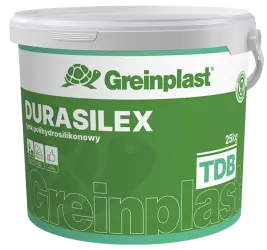

Used on external facades, to be applied by spraying. Can be applied on all typical mineral bases, such as: concrete, cement, cement-lime, lime-cement, lime plasters etc. after a minimum of 28 days after they are placed, and as plastering on layers with mesh reinforcement in Greinplast insulation systems, minimum 3 days after they are laid. It is an integral element of product ranges in Greinplast A insulation systems (according to AT) and Greinplast EPS (according to ETA). The material available in colours that can be found in the manufacturer's colour scheme. Upon the customer's request, other colour schemes are available, provided by Greinplast Tinting System (SBG).
Packaged in 25kg containers.
Before the application, the mass needs to be well agitated with a low-revolution agitator. In order to achieve the correct working consistence, it is allowed to add a small amount of water (not more than 0.2 l per package). The volume of added water should be identical for each package. The plaster should be applied with a spraying unit, using a gun with exchangeable nozzles. The spraying pressure and nozzle size should be matched with the plaster graining. The mass should be applied uniformly along the entire surface, in horizontal strips, beginning from the top edge. Pay attention for the sprayed mass to precisely cover the entire area, so that the need of re-spraying could be eliminated. Otherwise, after the plaster dries off, colour differences can be observed, resulting from prime layer being visible from beneath or from texture differences. If necessary, additional plaster must be applied following the “wet on wet” method. The plaster must be secured against the influence of weather factors, until completely dry. When templates are used, before the application begins, the surfaces to be treated need to be covered with templates imitating brick or natural stone. The templates should be pressed against the base with a rubber roller, so that the sprayed substance does not cause their coming off. The plaster should be sprayed as described above, and the templates should be removed 10-15 minutes after the plaster application.
Show moreThe ambient temperature during the plaster application and drying should be between +5°C and +30°C. The optimal application temperature is +20°C. During the plaster application, until it is completely dry (minimum 3 days from the work completion); it is strictly recommended that care should be taken to secure the plaster against adverse weather conditions. During this period, temperatures below 5°C are not allowed. The plaster drying time may vary greatly, especially during periods with adverse weather conditions. Failure to observe the aforementioned recommendations, bad base preparation or incorrect plaster application may lead to the appearance of permanent colour differences on plastering surfaces (efflorescences, dye penetration), and in extreme scenarios – reduction of its durability and even flaking. The product contains admixtures that may have aggressive action on metals, glass and wood. Surfaces exposed to soiling with plaster should be secured, and when soiling occurs, remove stains before they turn dry.
Information contained in the manual help ensure the optimal use of the product, however, it does not create any legal liability of the Manufacturer, due to the fact that the conditions of use remain outside of its control. We do not accept any responsibility if the material is combined with products from other Manufacturers or with such that are not listed in the reference documents (AT & ETA).